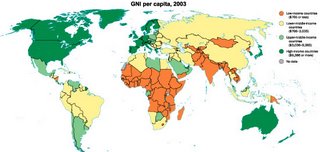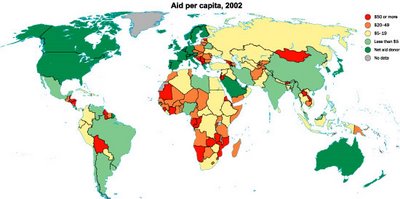
The problem presents itself, for some Americans, because quantifiable results aren't immediately available. There are examples of rapid transformation, though it usually followed reconstruction (after dropping bombs). Reconstruction seems acceptable to the American public, but construction for dispossessed citizenries should be limited and brief, or occur not at all? That is drivel.
Underdeveloped nations have human potential and investment in education, sanitation, infrastructure, and municipal construction will render long-term dividends. Helping people secure modern life's essentials (food, shelter, and security) allows them more time to think critically or creatively; both are essential for cultural or technical advancement.

**This map depicts Aid Per Person;
Red = $50 or more, Orange = $20-49, Yellow = $5-19, Lime = $5 or less, Green = Net Aid Donor
In my estimation, India is an exemplary model for the benefits of international investment. Aid has many forms and, according to Thomas Friedman, Foreign Direct Investment (FDI) by American corporations built India's IT infrastructure. Now, Indians and Americans are enjoying net benefits because of mutual faith in one another. India is still, on the whole, a poor nation; yet they require very little international aid. This is a classic example of non-state investment turning into development assistance, an occurrence more and more common in our globalizing world.
This brings me back to my initial point; helping those in need will generate gratitude, though immediate quantification is difficult, if not impossible. This is especially true while aiding nations with overtly inimical governments. In my opinion, international aid repays itself in spades.
- Top importer of goods from developing countries in 2004 with $661 billion
- World's largest single country donor of foreign aid. According to preliminary figures, annual official development assistance nearly tripled from $10 billion in 2000 to $27.5 billion in 2005
- $2.7 billion in HIV/AIDS funding through the President's Emergency Plan for AIDS Relief in 2005
- $7.8 billion in bilateral humanitarian relief and reconstruction assistance in 2005. This expenditure consisted of $3.6 billion for humanitarian relief and $4.2 billion for reconstruction
- $6.8 billion in private charitable contributions to developing countries
* Courtesy of The World Bank, GNI per Capita 2003
** Courtesy of The World Bank, Aid per Capita, 2002
*** Courtesy of US Department of State, Some forms of government expenditures promote development but are not counted under the OECD DAC definition as part of Official Development Assistance (e.g. some forms of military assistance). All private sector programs and international trade are not considered part of ODA.




No comments:
Post a Comment